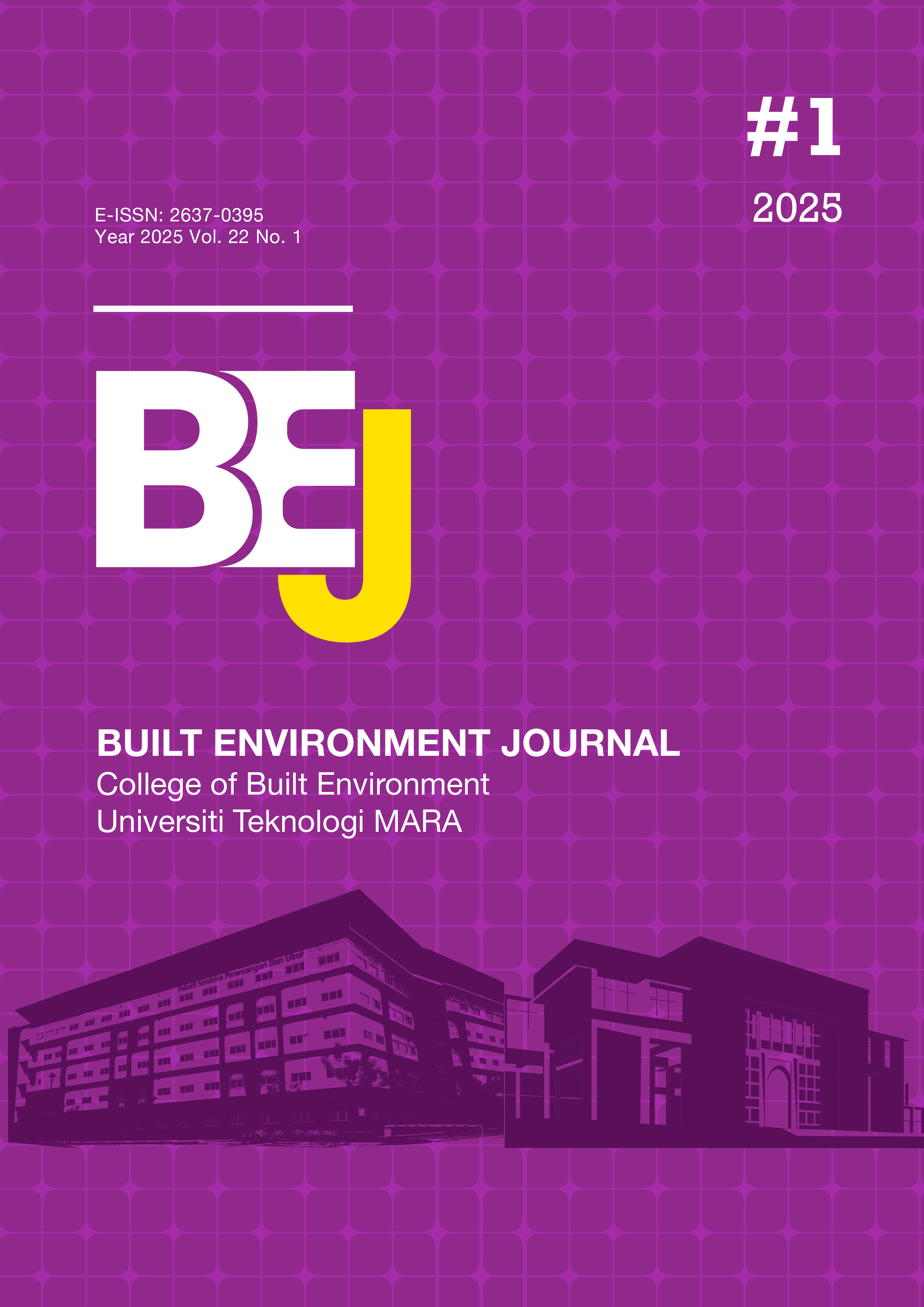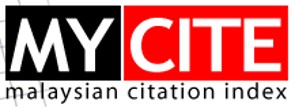Determining the Key Elements in Maintenance Planning of the Masjid Kariah in Malaysian Perspective
DOI:
https://doi.org/10.24191/bej.v22i1.928Keywords:
Masjid Kariah, Maintenance Strategy Criteria, Maintenance Performance, Measurement, Delphi Survey, MalaysiaAbstract
In Malaysia, mosques encounter various maintenance-related challenges including limited financial resources, a shortage of skilled labour, and the necessity to reconcile traditional architectural and design elements with modern building techniques specifically for Masjid Kariah. Non-existence of formal measurement criteria for efficient Masjid Kariah maintenance planning has led to the aim of this study, which was to determine the key elements in maintenance planning of the Masjid Kariah in a Malaysian perspective. The qualitative approach was employed in this study through a Delphi survey where semi-structured interviews were conducted to 11 experts from academicians, maintenance practitioners and governments' sectors. The formation of conceptual framework through reviewing previous studies has helped the identification of the key elements. Thus, the results revealed that all 11 experts have been agreed and validated establishing 10 key elements in maintenance planning, which are Planned Preventive Maintenance, Planned Corrective Maintenance, Corrective Maintenance, Organisation Management, Planning and Scheduling, Financial Provision, Service Quality, Assessment, Resources Allocation and Safety and Health specifically for the Masjid Kariah. Hence, the stakeholders can develop a holistic maintenance planning based on those 10 key elements for Masjid Kariah. In conclusion, the combination between maintenance strategy and maintenance performance measurement can foster a good practice for maintenance planning.
References
Ahmad, R., Arsad, S., Said, R., Hassan, A., & Shahabuddin, S. (2020). Development of Framework for Good Governance Index for Mosques in Kedah. Development, 7(19), 2020. Retrieved from: ISSN: 2394-5125, https://doi.org/10.31838/jcr.07.19.1041
Al-Najjar, B. & Alsyouf, I. (2003). Selecting the most efficient maintenance approach using fuzzy multiple criteria decision making. International Journal of Production Economics, 84(1), 85-100. Retrieved from: https://doi.org/10.1016/S0925-5273(02)00380-8
Amaratunga, D. & Baldry, D. (2002). Moving from performance measurement to performance management. Facilities, 20(5/6), 217-223. Retrieved from: https://doi.org//10.1108/02632770210426701
British Standard 3811 (1993). British Standard Guide to Building Maintenance Management. Glossary of terms used in terotechnology, BS 3811:1993 C.F.R. https://doi.org/10.3403/00319632
Brown, M. G., Hitchcock, D. E. & Willard, M. L. (1994). Why TQM Fails and What to Do About It. Burr
Ridge, IL: Irwin Professional Publishers. Castro, E.(1999). PERL and CGI for the World. Retrieved from: https://doi.org/10.4236/jss.2016.411017
Cholasuke, C., Bhardwa, R. & Antony, J. (2004). The status of maintenance management in UK manufacturing organisations: results from a pilot survey. Journal of Quality in Maintenance Engineering, 10(1), 5-15. Retrieved from: https://doi.org/10.1108/13552510410526820
Ding, S.-H., & Kamaruddin, S. (2015). Assessment of distance-based multi-attribute group decision-making methods from a maintenance strategy perspective. Journal of Industrial Engineering International, 11(1), 73-85. Retrieved from: https://doi.org/10.1007/s40092-014-0078-2
Hamdan, W. S. Z. W., Hashim, M. H. M. H., Radzuan, N. A. M., Hassin, M. A. & Ismail, R. A. (2023). The Importantce Maintenance Budgeting for the Mosques Management in Malaysia: A Systematic Literature Review. Journal of Tourism, Hospitality and Environment Management, 8(34), 78-92. Retrieved from: https://doi.org/10.35631/JTHEM.834006
Hassan, S. N. S., Seh, H., Mohamad, K., & Tawil, S. F. M. (2021). Managing Website Development for Darul Hana Mosque in Sarawak by Implementing ADDIE Approach. UMRAN-International Journal of Islamic and Civilizational Studies, 8(1). Retrieved from: https://doi.org/10.11113/umran2021.8n1.457
Johnson, T. M., & Crossing, P. F. (2020). The World by Religion. Journal of Religion and Demography, 7(1), 4-91. Retrieved from: https://doi.org/10.1163/2589742x-12347101
Ku, S. & Kim, C. (2019). Development of a model for maintenance performance measurement. Journal of Quality in Maintenance Engineering, 26(1), 69-86. Retrieved from https://doi.org/10.1108/jqme-07-2018-0060
Loosemore, M. & Hsin, Y. (2001). Customer-focused benchmarking for facilities management. Facilities, 19(13/14), 464-476. Retrieved from: https://doi.org/10.1108/EUM0000000006204
Nilsson, J. & Bertling, L. (2007). Maintenance management of wind power systems using condition monitoring systems—life cycle cost analysis for two case studies. IEEE Transactions on energy conversion, 22(1), 223-229. Retrieved from: https://doi.org/10.1109/TEC.2006.889623
Parida, A. & Kumar, U. (2009). Maintenance productivity and performance measurement. In Handbook of maintenance management and engineering (pp. 17-41): Springer. Retrieved from: https://doi.org/10.1007/978-1-84882-472-0_2
Rani, N. A. A., Baharum, M. R., Akbar, A. R. N. & Nawawi, A. H. (2015). Perception of Maintenance Management Strategy on Healthcare Facilities. Procedia - Social and Behavioral Sciences, 170, 272-281. Retrieved from: https://doi.org/10.1016/j.sbspro.2015.01.037
Ruparathna, R., Hewage, K. & Sadiq, R. (2018). Multi-period maintenance planning for public buildings: A risk based approach for climate conscious operation. Journal of Cleaner Production, 170, 1338-1353. https://doi.org/10.1016/j.jclepro.2017.09.178
Sapril, M., Muin, Z. A. & Sipan, I. (2016). Key Drivers of an Effective Facilities Management Practice for Malaysia State Mosque MATEC Web of Conferences, 66, 9. Retrieved from: https://doi.org/10.1051/matecconf/20166
Seeley, I. H. (1987). Building maintenance: Macmillan International Higher Education. Retrieved from: https://doi.org/10.1007/978-1-349-18925-0
Shoemaker, S. J. (2021). 15 On the Holy Places Adomnán/Arculf. In A Prophet Has Appeared (pp. 164-170): University of California Press. Retrieved from: ISBN: 9780520299610
Sofii, I., & Pertiwi, I. (2021). The Role of The Mosque in Economic Empowerment and Community Welfare Through MSMEs in The South Jakarta Region. JES (Jurnal Ekonomi Syariah), 6(1), 36-52. Retrieved from: https://doi.org/10.30736/jesa.v6i1.122
Swanson, L. (2001). Linking maintenance strategies to performance. International Journal of Production Economics. 70(3), 237-244. Retrieved from: https://doi.org/ 10.1016/s0925-5273(00)00067-0
Tsang, A. H. C., Jardine, A. K. S., & Kolodny, H. (1999). Measuring maintenance performance: a holistic approach. International Journal of Operations & Production Management, 19(7), 691-715. https://doi.org/10.1108/01443579910271674
Waeyenbergh, G., & Pintelon, L. (2002). A framework for maintenance concept development. International Journal of Production Economics, 77(3), 299-313. https://doi.org/10.1016/s0925-5273(01)00156-6
Wang, L., Chu, J. & Wu, J. (2007). Selection of optimum maintenance strategies based on a fuzzy analytic hierarchy process. International Journal of Production Economics, 107(1), 151-163. https://doi.org/10.1016/j.ijpe.2006.08.005
Downloads
Published
How to Cite
Issue
Section
License
Copyright (c) 2024 Azhar Yusof, Mohammad Ridzuan Yahya, Mohd Saidin Misnan

This work is licensed under a Creative Commons Attribution-NonCommercial-NoDerivatives 4.0 International License.
CC BY-NC-ND 4.0 DEED
Attribution-NonCommercial-NoDerivs 4.0 International












